As far as I can tell, the problem is with your data, not with your code. The example data you posted only has one row per participant/condition at most; there isn't a FA_3 or FA_4 for participant 988. If your real data doesn't have enough data for each combination of participant and conditions, then it looks like sdTrim just averages by participant.
I'm unfamiliar with reaction time data, but you might be able to accomplish what you're looking for using group_by and summarize from dplyr.
Below is an example with a larger dataset based on your example data.
library(trimr)
set.seed(123)
participant <- c(rep("1", 100), rep("2", 100), rep("3", 100))
accuracy <- sample(x = c("1", "0"), size = 300, replace = TRUE, prob = c(.9, .1))
condition <- sample(x = c("hit_1", "FA_1", "hit_2", "FA_2", "hit_3", "FA_3", "FA_4", "hit_4", "hit_1", "FA_1", "hit_2", "FA_2", "hit_3", "hit_4"), size = 300, replace = TRUE)
rt <- sample(x = 250:625, size = 300)
new_data <- data.frame(participant, accuracy, condition, rt)
trimmedData <- sdTrim(data = new_data,
minRT = 150,
sd = 2,
pptVar = "participant",
condVar = "condition",
rtVar = "rt",
accVar = "accuracy",
perParticipant = TRUE,
returnType = "mean")
print(trimmedData)
participant FA_1 hit_1 hit_3 hit_2 FA_4 FA_2 FA_3 hit_4
1 1 439.800 477.250 433.85 440.375 426.286 439.500 508.8 457.429
2 2 477.067 489.933 466.50 360.000 405.000 387.533 427.2 428.364
3 3 398.333 446.500 438.00 362.077 445.000 432.333 419.2 497.125
Update (1/23/23)
In both your original and your updated datasets, you simply don't have enough values per condition to properly use sdTrim() with both participant = TRUE and condition = TRUE (condition is automatically set to TRUE if you don't specify it).
Here is a link to the sdTrim() function on Github. Start looking at line 545, which describes what happens when you have both participant and condition set to TRUE.
Part of this function involves taking the standard deviation of the data for each combination of participant and condition. If you only have one value for each combination of participant and condition, your standard deviation value will be NA. See the below example of just using participant 988 and condition hit_4. Once your standard deviation is NA, NA's just follow after that.
You either need a larger dataset with more values for each combination of participant and condition or you need to set perParticipant and perCondition to both be FALSE. If you do the second option, you will have two NaN values because those values fall under the minRT threshold that you set. However, you can avoid that by also doing returnType = "raw".
new_data <- structure(list(participant = c("986", "986", "986", "986", "986", "986", "986", "986", "988", "988", "988", "988", "988", "988", "988", "988"), accuracy = c("1", "1", "1", "1", "1", "1", "1", "1", "1", "1", "1", "1", "1", "1", "1", "1"), condition = c("hit_1", "FA_1", "hit_2", "FA_2", "hit_3", "FA_3", "FA_4", "hit_4", "hit_1", "FA_1", "hit_2", "FA_2", "hit_3", "hit_4", "FA_3", "FA_4"), rt = c(638, 286, 348, 310, 404, 301, 216, 534, 348, 276, 256, 293, 495, 438, 73, 73)), row.names = c(NA, -16L), class = "data.frame")
stDev <- 2
minRT <- 150
# get the list of participant numbers
participant <- unique(new_data$participant)
# get the list of experimental conditions
conditionList <- unique(new_data$condition)
# trim the data
trimmedData <- new_data[new_data$rt > minRT, ]
# ready the final data set
finalData <- as.data.frame(matrix(0, nrow = length(participant), ncol = length(conditionList)))
# give the columns the condition names
colnames(finalData) <- conditionList
# add the participant column
finalData <- cbind(participant, finalData)
# convert to data frame
finalData <- data.frame(finalData)
# intialise looping variable for subjects
i <- 1
j <- 2
# take apart the loop
# focus on participant 988, condition hit_4
currSub <- "988"
currCond <- "hit_4"
# get relevant data
tempData <- trimmedData[trimmedData$participant == currSub & trimmedData$condition == currCond, ]
# find the cutoff
curMean <- mean(tempData$rt)
print(curMean)
[1] 438
curSD <- sd(tempData$rt)
print(curSD) # <- here is where the NA values start
[1] NA
curCutoff <- curMean + (stDev * curSD)
# trim the data
curData <- tempData[tempData$rt < curCutoff, ]
# find the average, and add to the data frame
finalData[i, j] <- round(mean(curData$rt))
head(finalData)
> participant hit_1 FA_1 hit_2 FA_2 hit_3 FA_3 FA_4 hit_4
1 986 NA 0 0 0 0 0 0 0
2 988 0 0 0 0 0 0 0 0

